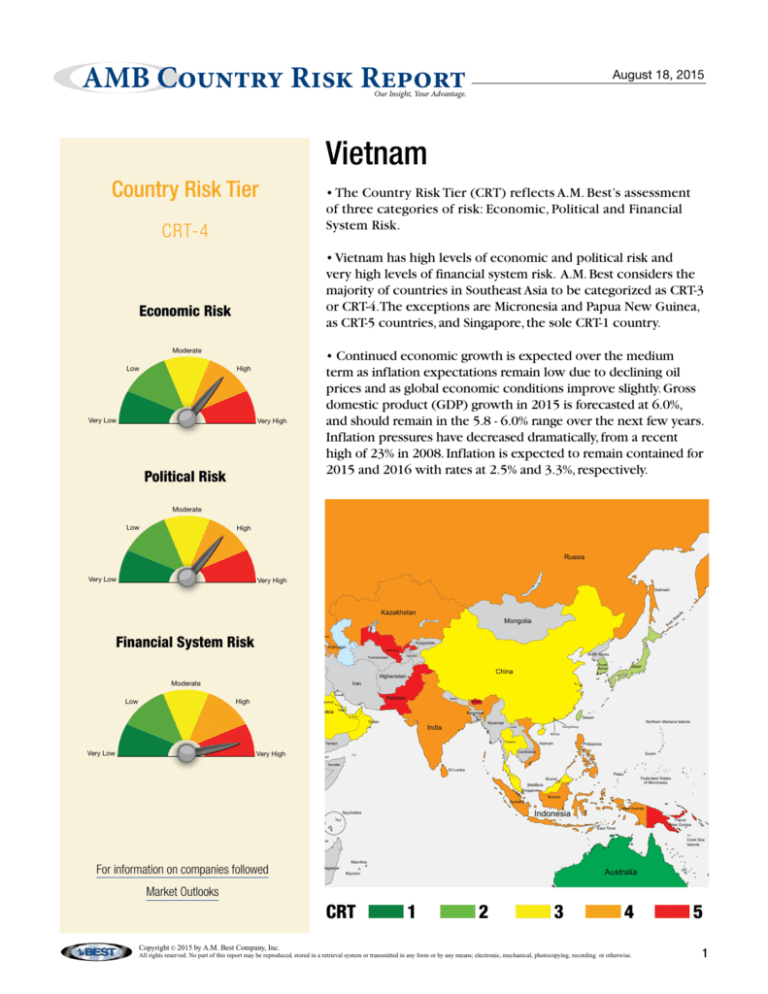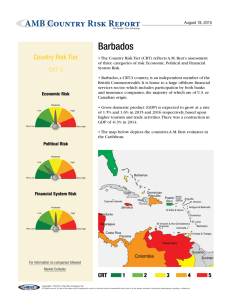
AMB Country Risk Report
August 18, 2015
Our Insight, Your Advantage.
Vietnam
Country Risk Tier
• The Country Risk Tier (CRT) reflects A.M. Best’s assessment
of three categories of risk: Economic, Political and Financial
System Risk.
CRT-4
• Vietnam has high levels of economic and political risk and
very high levels of financial system risk. A.M. Best considers the
majority of countries in Southeast Asia to be categorized as CRT-3
or CRT-4.The exceptions are Micronesia and Papua New Guinea,
as CRT-5 countries, and Singapore, the sole CRT-1 country.
Economic Risk
Moderate
Low
• Continued economic growth is expected over the medium
term as inflation expectations remain low due to declining oil
prices and as global economic conditions improve slightly. Gross
domestic product (GDP) growth in 2015 is forecasted at 6.0%,
and should remain in the 5.8 - 6.0% range over the next few years.
Inflation pressures have decreased dramatically, from a recent
high of 23% in 2008. Inflation is expected to remain contained for
2015 and 2016 with rates at 2.5% and 3.3%, respectively.
High
Very Low
Very High
Political Risk
Moderate
Iceland
Finland
Greenland
Sweden
Low
High
Norway
Estonia
Isle of Man
Very Low
Ireland
Russia
Russia
Latvia
Denmark
Lithuania
Very High
Belarus
United
Kingdom
Netherlands
Guernsey
Liechtenstein
Czech
Republic
Austria
Switzerland
France
Ukraine
Slovakia
Luxembourg
Jersey
Sakhalin
Poland
Germany
Belgium
Bosnia & Serbia
Herzegovina
Andorra
Financial System Risk
Azores
Georgia
Macedonia
Armenia
Albania
Gibraltar
Tunisia
Canary
Islands
Malta
Cyprus
Syria
Moderate
South
Korea
China
Japan
Iran
Jordan
Kuwait
LibyaHigh
Saudi Arabia
(Occupied by Morocco)
Mauritania
Pakistan
Bahrain
Egypt
Western Sahara
Nepal
Qatar
Bhutan
Bangladesh
U.A.E.
Oman
Myanmar
India
Taiwan
Wake Island
Macau
Chad
Senegal
Eritrea
Sudan
Gambia
Benin
Ethiopia
Brunei
Gabon
Uganda
Palau
Malaysia
Singapore
Kenya
Sumatra
Rwanda
Dem. Republic
Burundi
of Congo
Seychelles
Tanzania
zil
Malawi
Nauru
New Guinea
Zimbabwe
Market Outlooks
Mauritius
Madagascar
Botswana
Solomon Islands
Reunion
Australia
New Caledonia
Swaziland
Lesotho
South Africa
Tuvalu
Vanuatu
Mozambique
For information on companies followed
Papua
New Guinea
Coral Sea
Islands
Comoros
Zambia
Namibia
Federated States
of Micronesia
Borneo
Indonesia
East Timor
Angola
Marshall Islan
Guam
Sri Lanka
Cameroon
Congo
Philippines
Somalia
Central Africa Republic
Togo
Vietnam
Dijbouti
Nigeria
Equatorial Guinea
Sao Tome & Principe
Thailand
Yemen
Cambodia
Very High
Burkina Faso
Ghana
Guinea
Sierra
Cote d'Ivoire
Leone
Liberia
Northern Mariana Islands
Hong Kong
Laos
Mali
Niger
VeryGuinea-Bissau
Low
North Korea
Tajikistan
Afghanistan
Iraq
Israel
Algeria
Low
Cape Verde
Uzbekistan
Turkmenistan
Lebanon
Morocco
s
nd
la
Is
Kyrgyzstan
Azerbaijan
Turkey
Greece
Monaco
ril
Ku
Russia
Bulgaria
Montenegro
Italy
Spain
Portugal
Mongolia
Romania
Croatia
San Marino
Kazakhstan
Republic of
Moldova
Hungary
Slovenia
Norfolk Island
CRT 1 2 3 4 5
Copyright © 2015 by A.M. Best Company, Inc.
All rights reserved. No part of this report may be reproduced, stored in a retrieval system or transmitted in any form or by any means; electronic, mechanical, photocopying, recording or otherwise.
1
New Zealand
F
AMB Country Risk Report
Vietnam
Regional Summary: Southeast Asia
• Economic growth for the region will
vary depending on country specific
factors. Gross domestic product growth for
the Association of Southeast Asian Nations
(ASEAN) as a whole is forecasted at 5.1%
for 2015 and 5.3% for 2016. Growth is
expected to be driven by exports and an
increase in consumer consumption.
• Possible external risks for the region in
the coming year include the slowdown in
the Chinese economy, the normalization
of the United States monetary policy,
potential exchange rate volatility, lower
commodity prices, regional unrest and the
potential for increased political instability.
• Political changes and social unrest
could affect foreign direct investment
inflows and tourism revenues. The region
has been attractive due to low labor
costs, the prevalence of natural resources
and the need for new and improved
large scale infrastructure.
Vital Statistics 2014
Nominal GDP
Population
GDP Per Capita
Real GDP Growth
Inflation Rate
Premiums Written (Life)
Premiums Written (Non-Life)
Premiums Growth (2013 - 2014)
• Foreign direct investment continues
to expand.The country has favorable
population demographics and
inexpensive labor costs. Additionally,
the government has plans to reduce the
corporate tax rate to 20% in 2016, in an
effort to remain regionally competitive
with Thailand and Cambodia.
186.05
90.6
2,053
6.0
4.1
1,290
1,293
13.5
Regional Comparison
Country Risk Tier
CRT-4
CRT-4
CRT-3
CRT-4
CRT-1
CRT-3
Vietnam
Indonesia
Malaysia
Philippines
Singapore
Thailand
Source: IMF, Axco, Swiss Re and A.M. Best
Economic Growth
Economic Risk: High
• The economy is dependent on the
manufacturing and agriculture sectors
as the main drivers of economic
growth. Manufacturing accounts for
approximately 20% of GDP, with exports
becoming increasingly oriented towards
higher-end electric goods. Nearly 50%
of the country’s labor force works in
agricultural related industries.
USD bn
mil
USD
%
%
USD mil
USD mil
%
25
Real GDP
CPI Inflation
20
15
%
10
5
0
2006
2007
2008
2009
2010
2011
2012
2013
2014
2015
2016
2017
2018
2019
2020
Source: IMF World Economic Outlook and A.M. Best
• Poverty levels continue to be high with
GDP per capita at approximately 2,100 USD.
2
AMB Country Risk Report
Vietnam
Political Risk: High
Political Risk Summary
• The Communist Party Congress will be
held in 2016; new committee members
are chosen every five years. Prime minister
Dung is ineligible to stand for another
term, however, his successor is likely to
continue his policy programs.
Score 1 (best) to 5 (worst)
Vietnam
World Average
International Transactions
Policy
5
4
Legal System
Monetary Policy
3
• Plans for economic liberalization will
accelerate as the government intends to
sell almost 300 state owned enterprises
in 2015. While it is expected that this
goal will not be met, it does indicate the
government’s continued resolve following
progress made in 2014.
2
1
Regional Stability
Fiscal Policy
0
Social Stability
Business Environment
Government Stability
• Despite consistent economic gains in
the last decade, development is hampered
by inadequate infrastructure, low human
capital, high levels of corruption and
pervasive bureaucracy.
Labor Flexibility
Source: A.M. Best
• Disputes between Vietnam and China
over oil-rich islands in the South China
Sea have created political tensions.
Additionally, these disputes sparked
riots against Chinese-owned factories in
Vietnamese manufacturing hubs.
GDP Per Capita and Population
for Selected Countries
Financial System Risk: Very High
60,000
300
GDP Per Capita
Population
250
40,000
200
USD
Millions
50,000
30,000
150
20,000
100
10,000
50
0
Vietnam
Indonesia
Source: IMF and A.M. Best
Malaysia
Philippines
Singapore
Thailand
0
• The insurance industry is regulated by
the Ministry of Finance.
• The country has improving, but
underdeveloped, monetary framework and
capital markets.
• The Vietnam Asset Management
Corporation (VAMC) bought 5.7 billion
USD in troubled loans in February of 2015.
Non- performing loans are estimated to
have decreased from 9% in 2012 to 4.9%
in 2014.
• The state is encouraging mergers of
banks to strengthen the financial system.
It aims to reduce the number of banks
from 40 to as few as 15 by 2017.
3
AMB Country Risk Report
Vietnam
GUIDE TO BEST’S COUnTry rISk TIErS
A.M. Best defines country risk as the risk that country-specific factors could adversely affect the claims-paying ability of an insurer. Country risk is
evaluated and factored into all Best’s Credit Ratings. Countries are placed into one of five tiers, ranging from “CRT-1” (Country Risk Tier 1), denoting
a stable environment with the least amount of risk, to “CRT-5” (Country Risk Tier 5) for countries that pose the most risk and, therefore, the greatest
challenge to an insurer’s financial stability, strength and performance.
A.M. Best’s Country Risk Tiers are not credit ratings and are not directly comparable to a sovereign debt rating, which evaluates the ability and
willingness of a government to service its debt obligations.
Country risk Tiers
Country risk Tier
Definition
CRT-1
Predictable and transparent legal environment, legal system and business infrastructure; sophisticated financial
system regulation with deep capital markets; mature insurance industry framework.
CRT-2
Predictable and transparent legal environment, legal system and business infrastructure; sufficient financial system
regulation; mature insurance industry framework.
CRT-3
Developing legal environment, legal system and business environment with developing capital markets; developing
insurance regulatory structure.
CRT-4
Relatively unpredictable and nontransparent political, legal and business environment with underdeveloped capital
markets; partially to fully inadequate regulatory structure.
CRT-5
Unpredictable and opaque political, legal and business environment with limited or nonexistent capital markets; low
human development and social instability; nascent insurance industry.
Country risk reports
A.M. Best Country Risk Reports are designed to provide a brief, high-level explanation of some of the key factors that determine a country’s Country
Risk Tier assignment. It is not intended to summarize A.M. Best’s opinion on any particular insurance market or the prospects for that market.
Categories of risk
Country Risk Reports provide scores for three categories of risk for each country. These scores are (1) Very Low; (2) Low; (3) Moderate; (4) High
and (5) Very High.
Category of risk
Definition
Economic Risk
The likelihood that fundamental weaknesses in a country’s economy will cause adverse developments for an insurer.
A.M. Best’s assessment of economic risk evaluates the state of the domestic economy, government finances and
international transactions, as well as prospects for growth and stability.
Political Risk
The likelihood that government or bureaucratic inefficiencies, societal tensions, inadequate legal system or
international tensions will cause adverse developments for an insurer. Political risk comprises the stability of the
government and society, the effectiveness of international diplomatic relationships, the reliability and integrity
of the legal system and of the business infrastructure, the efficiency of the government bureaucracy, and the
appropriateness and effectiveness of the government’s economic policies.
Financial System Risk
Financial system risk (which includes both insurance and non-insurance financial system risk) is the risk that financial
volatility may erupt due to inadequate reporting standards, weak banking system or asset markets, and/or poor
regulatory structure. In addition, it includes an evaluation of whether the insurance industry’s level of development and
public awareness, transparent and effective regulation and reporting standards, and sophisticated regulatory body will
contribute to a volatile financial system and compromise the ability of an insurer to pay claims.
Political risk Summary
To provide additional detail on the political risk in a given domicile the Country Risk Reports include the Political Risk Summary. The Political Risk
Summary is a radar chart that displays scores for nine different aspects of political risk scored on a scale of one to five with one being the least
amount of risk and five being the highest amount of risk.
Category
Definition
International Transactions
Policy
Measures the effectiveness of the exchange rate regime and currency management.
Monetary Policy
Measures the ability of a country to effectively implement monetary policy.
Fiscal Policy
Measures the ability of a country to effectively implement fiscal policy.
Business Environment
Measures the overall quality of the business environment and ease of doing business.
Labor Flexibility
Measures the flexibility of the labor market, including the company’s ability to hire and fire employees.
Government Stability
Measures the degree of stability in a government.
Social Stability
Measures the degree of social stability, including human development and political rights.
Regional Stability
Measures the degree of stability in the region.
Legal System
Measures the transparency and level of corruption in the legal system.
Country risk Tier Disclosure
A Country Risk Tier (CRT) is not a credit rating, rather it represents a component of A.M. Best’s Credit Rating Methodology that is applied to all
insurers. A CRT is not a recommendation to purchase, hold or terminate any security, insurance policy, contract or any other financial obligation
issued by a government, an insurer or other rated issuer, nor does it address the suitability of any particular policy, contract or other financial
obligation for a specific purpose or purchaser.
Copyright © 2015 by A.M. Best Company, Inc.
Version 091714
Copyright © 2015 by A.M. Best Company, Inc.
All rights reserved. No part of this report may be reproduced, stored in a retrieval system or transmitted in any form or by any means; electronic, mechanical, photocopying, recording or otherwise.
4












